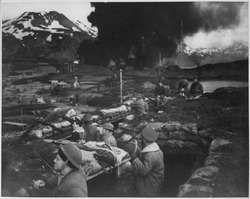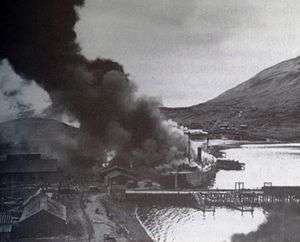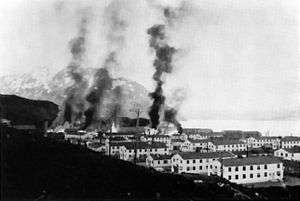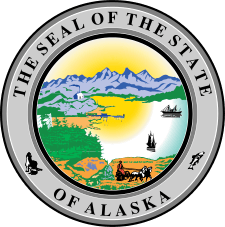Battle of Dutch Harbor
The Battle of Dutch Harbor took place on 3–4 June 1942, when the Imperial Japanese Navy launched two aircraft carrier raids on the Dutch Harbor Naval Operating Base and U.S. Army Fort Mears at Dutch Harbor on Amaknak Island, during the Aleutian Islands Campaign of World War II.
Overview
In this battle, a Japanese aircraft carrier strike force under Kakuji Kakuta launched air attacks over two days against the Dutch Harbor Naval Base and Fort Mears[1] in Dutch Harbor, Alaska. The attacks inflicted moderate damage on the U.S. base. Shortly thereafter, Japanese naval forces under Boshiro Hosogaya invaded and occupied Attu and Kiska islands in the Aleutians.
Background
On 3 June, a Japanese carrier strike force, under the command of Rear Admiral Kakuji Kakuta, comprising the carriers Ryūjō and Jun'yō, plus escort ships, sailed to 180 mi (160 nmi; 290 km) southwest of Dutch Harbor to launch air strikes at the United States Army and United States Navy facility to support a Japanese offensive in the Aleutians and in the central Pacific at Midway. The Japanese planned to occupy islands in the Aleutians in order to extend their defensive perimeter in the North Pacific to make it more difficult for the U.S. to attack Japan from that area.
Dutch Harbor was ringed with anti aircraft artillery batteries from the 206th Coast Artillery (Anti Aircraft), Arkansas National Guard.[2] The 206th CA (AA) was deployed to Dutch Harbor in the Aleutian Islands, Alaska, in August 1941 and had been on station for approximately four months when the Japanese Navy attacked Pearl Harbor on 7 December. The 206th CA was equipped with the 3-inch Gun M1918 (an older model with a vertical range of 26,902 ft (8,200 m)), .50in (12.7mm) M2 Browning machine guns, and 60 in (150 cm) Sperry searchlights. The 206th had one radar in position at Dutch Harbor at the time of the attack.
Battle

Shortly before dawn at 02:58, given the geographic latitude and longitude, Admiral Kakuta ordered his aircraft carriers to launch their strike which was made up of 12 A6M Zero fighters, 10 B5N Kate high-level bombers, and 12 D3A Val dive bombers which took off from the two small carriers in the freezing weather to strike at Dutch Harbor.
The planes arrived over the harbor at 04:07, and attacked the town′s radio station and oil storage tanks causing some damage. Many members of the 206th were awakened on 3 June by the sound of bombs and gunfire. While the unit had been on alert for an attack for many days, there was no specific warning of the attack before the Japanese planes arrived over Dutch Harbor. With no clear direction from headquarters, other than an initial cease fire order which was quickly withdrawn, gun crews from every battery quickly realized the danger, ran to their guns stationed around the harbor and began to return fire. In addition to their 3 in (76 mm) guns, 37 mm (1.46 in) guns and .50 in (12.7 mm) machine guns, members of the unit fired their rifles and one even claimed to have hurled a wrench at a low-flying enemy plane. Several members reported being able to clearly see the faces of the Japanese aviators as they made repeated runs over the island.[3] The highest casualties on the first day occurred when bombs struck barracks 864 and 866 in Fort Mears, killing 17 men of the 37th Infantry and eight from the 151st Engineers.[4]
When all the Japanese planes were recovered, there were erroneous reports of enemy ships in the vicinity, but search planes found no ships within the area. During the search, four Nakajima E8N2 "Dave" two-seat reconnaissance planes—launched from the heavy cruisers Takao and Maya—encountered U.S. fighters searching for the departing Japanese squadron.
Aerial combat ensued and two of the reconnaissance aircraft were shot down and their two-man crews were captured by a U.S. patrol boat, while the two others were damaged. The two remaining Japanese planes managed to return to their ships, only to crash-land in the water. The crews of both were rescued. The first day of the Dutch Harbor air raid had inflicted little damage on the U.S. forces in the area.

The 206th CA spent much of the night of 3/4 June moving guns down off the mountain tops surrounding the harbor down into the city of Unalaska and into harbor facilities themselves. This was partially as a deception and partially to defend against an expected land invasion. Civilian contractors offered to help and were put to work filling sandbags to protect the new gun positions.
On 4 June, the Japanese carriers steamed to less than 100 mi (87 nmi; 160 km) south of Dutch Harbor to launch a second attack. At 16:00, a second airstrike of nine fighters, 11 dive bombers, and six level bombers took off and attacked the U.S. facilities at Dutch Harbor again less than an hour later. More targets were damaged including some grounded aircraft, an army barracks, oil storage tanks, aircraft hangar, and a few merchant ships in the port. When the Japanese returned on 4 June, the Zero fighters concentrated on strafing the gun positions while their bombers destroyed the fuel tanks located at the harbor. One wing of the military hospital at the base was destroyed.[5] After hitting the fuel tanks, the enemy dive-bombers and high-level bombers concentrated on the ships in the harbor, Fillmore and Gillis. Driven away from these two targets by intense anti-aircraft fire, they finally succeeded in destroying the station ship Northwestern which, because of its large size, they mistakenly believed was a warship. Northwestern was actually a transport ship which had been beached and used as a barracks for civilian workers. Although in flames and badly damaged, firefighters managed to save the hull. Its power plant was thereafter being used to produce steam and electricity for the shore installations.[6][7] An anti-aircraft gun was blown up by a bomb and four U.S. Navy servicemen were killed.[5]
Two Japanese dive bombers and one fighter, damaged by anti-aircraft fire, failed to return to their carriers. On the way back, the Japanese planes encountered an air patrol of six Curtiss P-40 fighters over Otter Point. A short aerial battle ensued which resulted in the loss of one Japanese fighter and two level bombers. Four out of the six U.S. fighters were lost as well.
Aftermath
During the 4 June raid, one above-mentioned Mitsubishi A6M2 Zero was damaged by ground fire and crash-landed on Akutan Island, about 20 mi (17 nmi; 32 km) northeast of Dutch Harbor. Although the pilot was killed, the plane was not seriously damaged. This Zero—known as the "Akutan Zero"—was recovered by American forces, inspected, and repaired. The recovery was an important technical intelligence gain for U.S., as it showed the strengths and weaknesses of the Zero′s design.[8]
The following day, Admiral Kakuta received orders to break off further attacks and head for the central Pacific to support the Combined Fleet which was retreating after being defeated at Midway. Two days later, a small Japanese invasion force landed and occupied two of the Aleutian islands, Attu and Kiska, without further incident.
Notes
- ↑ NPS Aviation History
- ↑ WILLIWAW WAR: The Arkansas National Guard in the Aleutians in World War II by Donald Goldstein and Katherine V. Dillon, March 1992, University of Arkansas Press, See Also, NEVER GIVE UP! A HISTORY OF THE 206TH COAST ARTILLERY (ANTI-AIRCRAFT) REGIMENT OF THE ARKANSAS NATIONAL GUARD IN THE SECOND WORLD WAR by William E. Maxwell, Jr. March 1992
- ↑ WILLIWAW WAR: The Arkansas National Guard in the Aleutians in World War II by Donald Goldstein and Katherine V. Dillon, March 1992, University of Arkansas Press, page 151
- ↑ WILLIWAW WAR: The Arkansas National Guard in the Aleutians in World War II by Donald Goldstein and Katherine V. Dillon, March 1992, University of Arkansas Press, page 152
- 1 2 Garfield, p. 49
- ↑ Garfield, pp. 48-49
- ↑ WILLIWAW WAR: The Arkansas National Guard in the Aleutians in World War II by Donald Goldstein and Katherine V. Dillon, March 1992, University of Arkansas Press, page 176
- ↑ O'Leary, Michael. United States Naval Fighters of World War II in Action. Poole, Dorset, UK: Blandford Press, 1980, pp 67–74. ISBN 0-7137-0956-1.
References
- Cloe, John Haile (1990). The Aleutian Warriors: A History of the 11th Air Force and Fleet Air Wing 4. Missoula, Montana, U.S.A.: Pictorial Histories Publishing Co., Inc. and Anchorage Chapter – Air Force Association. ISBN 0-929521-35-8.
- Dickrell, Jeff (2001). Center of the Storm: The Bombing of Dutch Harbor and the Experience of Patrol Wing Four in the Aleutians, Summer 1942. Missoula, Montana, U.S.A.: Pictorial Histories Publishing Co., Inc. ISBN 1-57510-092-4.
- Feinberg, Leonard (1992). Where the Williwaw Blows: The Aleutian Islands-World War II. Pilgrims' Process, Inc. ISBN 0-9710609-8-3.
- Garfield, Brian (1969). The Thousand-Mile War: World War II in Alaska and the Aleutians. Fairbanks, Alaska, USA: University of Alaska Press. ISBN 0-912006-83-8.
- Goldstein, Donald M.; Dillon, Katherine V. (1992). The Williwaw War: The Arkansas National Guard in the Aleutians in World. ISBN 1-55728-242-0.
- Lorelli, John A. (1984). The Battle of the Komandorski Islands. Annapolis, Maryland, USA: United States Naval Institute. ISBN 0-87021-093-9.
- Morison, Samuel Eliot (2001) [1951]. Aleutians, Gilberts and Marshalls, June 1942-April 1944, vol. 7 of History of United States Naval Operations in World War II. Champaign, Illinois, USA: University of Illinois Press. ISBN 0-316-58305-7.
- Parshall, Jonathan; Tully, Anthony (2005). Shattered Sword: The Untold Story of the Battle of Midway. Dulles, VA: Potomac Books. ISBN 1-57488-923-0.
- Perras, Galen Roger (2003). Stepping Stones to Nowhere, The Aleutian Islands, Alaska, and American Military Strategy, 1867 - 1945. Vancouver British Columbia: University of British Columbia Press. ISBN 1-59114-836-7.
- Okumiya, Masatake; Fuchida, Mitsuo (1955). Midway: The Battle that Doomed Japan. Random House Inc., New York: Ballantine Books. ISBN 0-345-34691-2.
Further reading
- MacGarrigle, George L. Aleutian Islands: The US army Campaigns in WWII]. The U.S. Army Campaigns of World War II. United States Army Center of Military History. CMH Pub 72-6. Retrieved 18 December 2013.
- Symonds, Craig L. The Battle of Midway (Pivotal Moments in American History) Oxford University Press, USA October 2011 ISBN 978-0195397932 pp 193–200
External links
- Air Raid on Dutch Harbor & Fort Mears - photos & documents
- Logistics Problems on Attu by Robert E. Burks.
- Aleutian Islands Chronology
- Aleutian Islands War
- Red White Black & Blue - feature documentary about The Battle of Attu in the Aleutians during World War II


